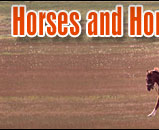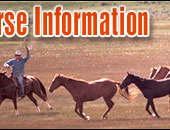 |
   |
|
|
|
You are here: Horses > Horse pasture / forage > Forage finals |
Probing Your Hay
Hay is a main staple of horse feed, and horse owners are understandably choosy
when it comes to finding and buying the best feed for their animals. Take a good
look at the hay you thinking of buying and also smell it.
|
|
|
The scent should be sweet and devoid of any traces of moldy odor. The color
should be a healthy green and not brown. Additionally, if you notice that the
tips of the hay or the leaves are bleached by the sun and appear burned, then
the hay is of decidedly lower quality since the protein levels are impaired.
For those who are serious about getting only the highest quality hays, consider
asking at the feed store if you are getting a first cutting or a subsequent one.
Generally speaking, hay from a first cutting is usually lower in protein and a
bit
|
stemmier than the second cutting. This is especially true for orchardgrass which
is much more palatable to horses if it comes from a second cutting. Of course,
looks are not everything, and if you are deeply concerned about the quality of
the hay or if you are thinking of purchasing a large amount, a probe should be
analyzed by a reputable lab that specializes in the testing of hay.
 Serious probes will be made
with a bona fide hay probe – a 20 inch tube that has a cutting edge on end and a
drill on the other. Boring into the bale, you will be able to extract a valid
sample that should be mixed with five or six samples from other bales of the
same cutting. A lab will then analyze the hay and provide you with the
information that deals with the moisture content, protein and fiber levels as
well as the TDN. Protein should usually be right around 10 to 17 percent while
TDN should test higher than 60 percent. Serious probes will be made
with a bona fide hay probe – a 20 inch tube that has a cutting edge on end and a
drill on the other. Boring into the bale, you will be able to extract a valid
sample that should be mixed with five or six samples from other bales of the
same cutting. A lab will then analyze the hay and provide you with the
information that deals with the moisture content, protein and fiber levels as
well as the TDN. Protein should usually be right around 10 to 17 percent while
TDN should test higher than 60 percent.
Obviously, this information will help you to decide how much and what to feed to
your animal. Keep in mind that performance horses will have different
nutritional needs than the average backyard horse. In addition to the foregoing,
if you purchase good quality hay with high protein content, you will not have to
supplement as much protein in your grain feed. Thus, a little probing at the
onset will save you money later on. Yet no matter what quality the probe
indicates the hay is, continue to be diligent when examining the hay visually!
Mold is not detected by a basic lab test.
 |
Read the next horse pasture article on Horse Fencing Systems. |
|
|
|
|
 |
|
|
|
|
|
Horse Education
|
|
|
|
|
Horse Information Topics
|
|
|
|
|
|
|
|
Horse Business Owners
|
| |
Advertise with Us
Have your horse products or services exposed to over 27,000 of our monthly visitors.
|
|
|
|
|
|